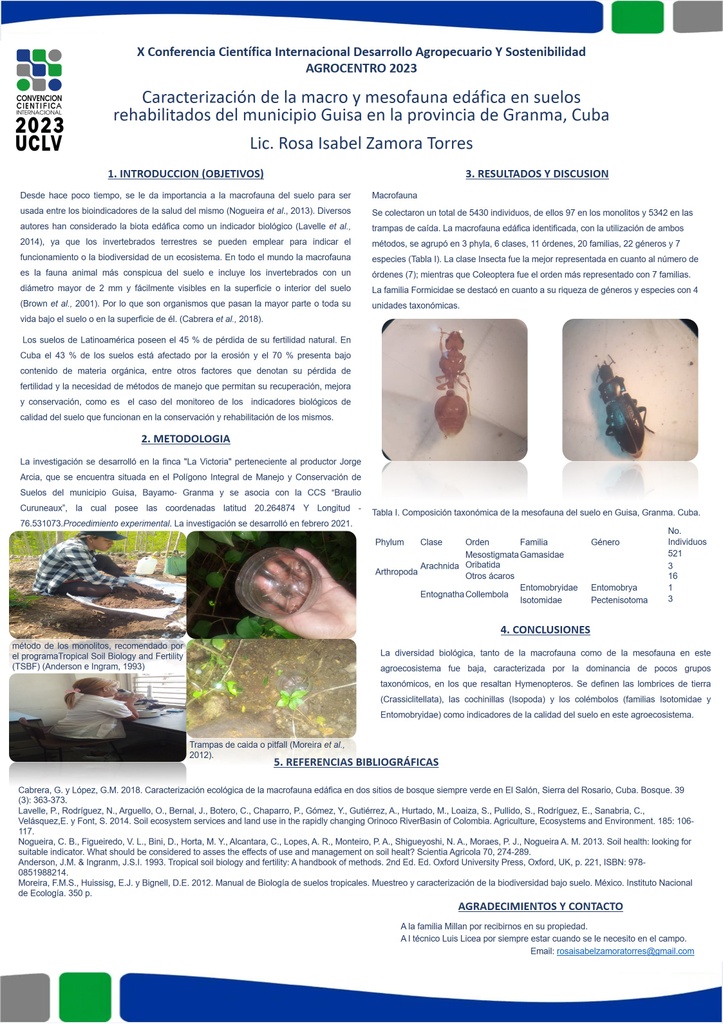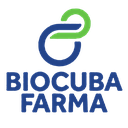Executive Secretary

10th International Scientific Conference on Agricultural Development and Sustainability
16th Symposium of Plant Protection

Abstract
In Cuba, there are few records of the use of some macrofauna and mesofauna taxa as indicators of soil quality. Recently, importance has been given to the soil macrofauna to be used among the bioindicators of soil health. Since terrestrial invertebrates can be used to indicate the functioning or biodiversity of an ecosystem, for this reason biological indicators of the quality of the edaphic environment were determined in rehabilitated soils of the municipality, Guisa in Granma province. The research was carried out in February 2021. The edaphic macrofauna was collected according to the standard methodology proposed by Tropical SoilBiology and Fertility and by the complementary methodology of pitfall traps. It was identified using taxonomic keys and references, with the collaboration of entomologists. The mesofauna was collected using pitfall traps and was represented by springtails, gammasin mites and oribatids. A total of 5438 individuals were collected, of them 97 in the monoliths and 5341 in the pitfall traps. The edaphic macrofauna identified, with the use of both methods, was grouped into three phyla, six classes, 11 orders, 20 families, 22 genera and seven species. The edaphic macrofauna community was dominated by Formicidae, which means that soil engineers had absolute control over this agroecosystem. Of 11 orders identified in total, 10 were collected in the monoliths, 10 in the traps, and six orders were collected in both methods.
Resumen
En Cuba, existen pocos antecedentes del uso de algunos taxa de la macrofauna y mesofauna como indicadores de la calidad del suelo. Desde hace poco tiempo, se le da importancia a la macrofauna del suelo para ser usada entre los bioindicadores de salud del mismo. Ya que los invertebrados terrestres se pueden emplear para indicar el funcionamiento o la biodiversidad de un ecosistema, por tal motivo se determinaron indicadores biológicos de la calidad del medio edáfico en suelos rehabilitados del municipio, Guisa en la provincia Granma. La investigación se realizó en febrero de 2021. La macrofauna edáfica se colectó según la metodología estándar propuesta por el Tropical SoilBiology and Fertility y por la metodología complementaria de las trampas de caída. Se identificó con el uso de claves y referencias taxonómicas, con la colaboración de entomólogos. La mesofauna se colectó mediante las trampas de caída y estuvo representada por colémbolos, ácaros gamasinos y oribatidos. Se colectaron un total de 5438 individuos, de ellos 97 en los monolitos y 5341 en las trampas de caída. La macrofauna edáfica identificada, con la utilización de ambos métodos, se agrupó en tres phyla, seis clases, 11 órdenes, 20 familias, 22 géneros y siete especies. La comunidad de la macrofauna edáfica estuvo dominada por Formicidae, lo que conlleva a que los ingenieros del suelo tuvieran un dominio absoluto en este agroecosistema. De 11 órdenes identificados en total, 10 se colectaron en los monolitos, 10 en las trampas y seis órdenes se colectaron en ambos métodos.
About The Speaker

Rosa Isabel Zamora Torres

Discussion

